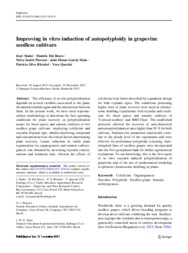Improving in vitro induction of autopolyploidy in grapevine seedless cultivars.
Improving in vitro induction of autopolyploidy in grapevine seedless cultivars.
Autoria: SINSKI, I.; BOSCO, D. D.; PIEROZZI, N. I.; MAIA, J. D. G.; RITSCHEL, P. S.; QUECINI, V.
Resumo: The efficiency of in vitro polyploidization depends on several variables associated to the plant, the antimicrotubule agent and the interactions between them. In the present work, we have used response-surface methodology to determine the best operating conditions for plant recovery in polyploidization assays for shoot apices and somatic embryos of two seedless grape cultivars, employing colchicine and oryzalin. Explant type, tubulin-interfering compound and concentration were the critical factors determining plant recovery. Linear reduction in viable plant regeneration via organogenesis and somatic embryogenesis was obtained by increasing oryzalin concentrations and treatment time, whereas the effects of colchicine were better described by a quadratic design for both explants types. The conditions promoting higher rates of plant recovery were used in chromosome doubling experiments with oryzalin and colchicine for shoot apices and somatic embryos of ?Crimson seedless? and ?BRS Clara?. The established protocols allowed the recovery of non-chimerical autotetraploid plants at rates higher than 30 % for both cultivars. Stomata size parameters statistically correlate to the ploidy level of the regenerants and were effective for preliminary polyploidy screening. Autotetraploid lines of seedless grapes were incorporated into the Vitis germplasm bank for further agronomical evaluations. To our knowledge, this is the first report of in vitro oryzalin induced polyploidization of grapevine and of the use of mathematical modeling to optimize chromosome doubling in plants.
Ano de publicação: 2014
Tipo de publicação: Artigo de periódico
Unidade: Embrapa Uva e Vinho
Palavras-chave: Genética, Poliploidia, Uva, Viticultura
Observações
1 - Por padrão são exibidas publicações dos últimos 20 anos. Para encontrar publicações mais antigas, configure o filtro ano de publicação, colocando o ano a partir do qual você deseja encontrar publicações. O filtro está na coluna da esquerda na busca acima.
2 - Para ler algumas publicações da Embrapa (apenas as que estão em formato ePub), é necessário ter, no celular ou computador, um desses softwares gratuitos. Sistemas Android: Google Play Livros; IOS: iBooks; Windows e Linux: software Calibre.
Acesse outras publicações
Acesse a Base de Dados da Pesquisa Agropecuária (BDPA) para consultar o acervo completo das bibliotecas da Embrapa.

